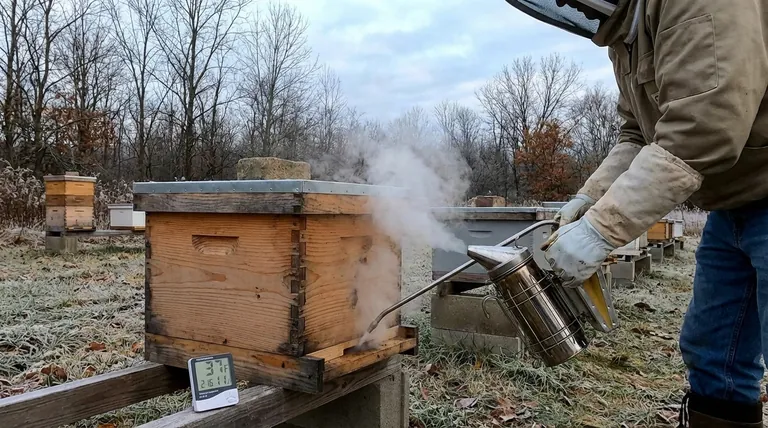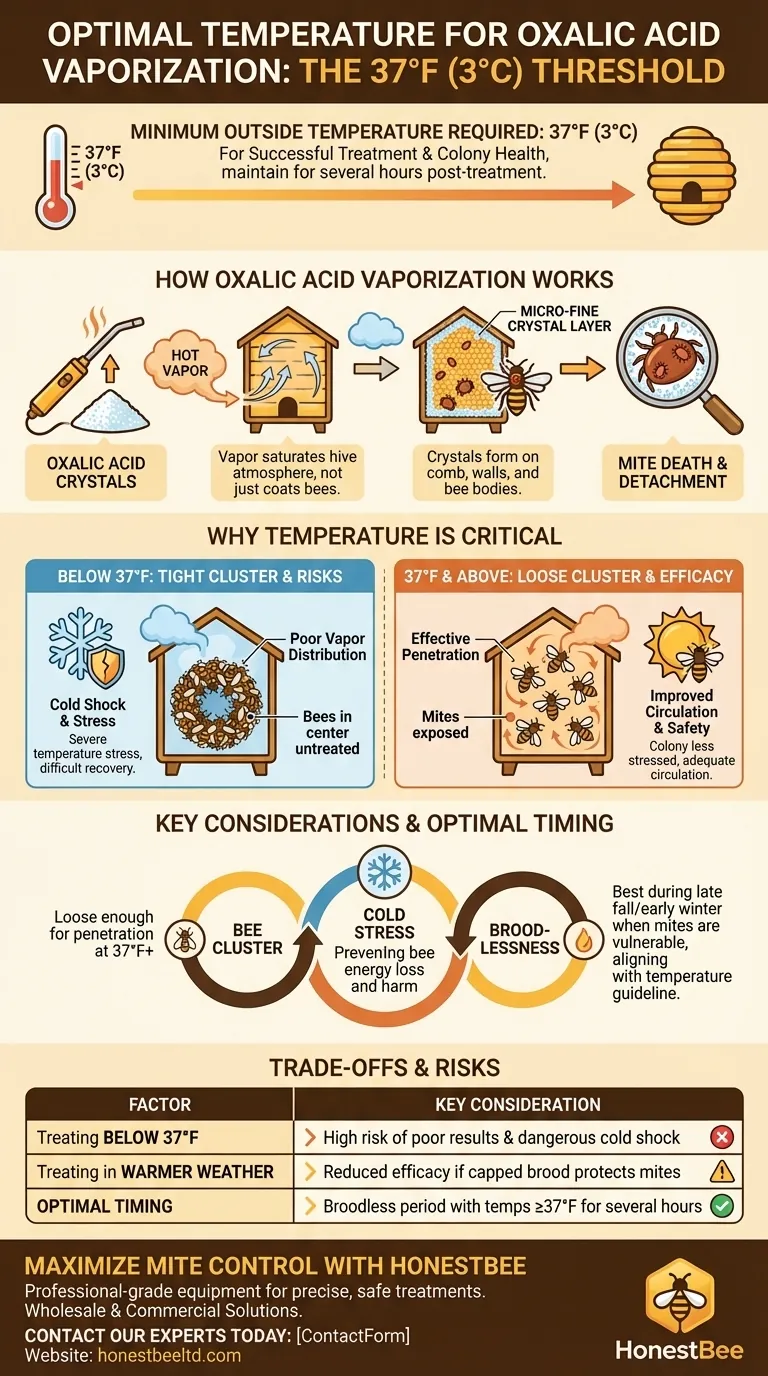For a successful treatment, the minimum outside air temperature required for oxalic acid vaporization is 37°F (approximately 3°C). Crucially, this temperature should be maintained for at least a few hours following the treatment to ensure the safety and health of the colony.
The 37°F guideline is less about the physics of vaporization and more about the biology of the honeybee. The temperature ensures the colony is not clustered too tightly, allowing for proper vapor distribution and preventing dangerous cold shock to the bees.

How Oxalic Acid Vaporization Works
The Vaporization Process
The treatment involves heating oxalic acid dihydrate crystals, typically on a specialized heating wand or plate. This device is inserted into the hive entrance, and as it heats up, the crystals sublimate—turning directly from a solid into a gas.
This hot vapor fills the interior space of the hive. The goal is not to coat the bees directly but to saturate the hive atmosphere with the vaporized acid.
From Vapor to Crystal
As the oxalic acid vapor cools inside the hive, it recrystallizes. It forms a micro-fine layer of sharp, spiky crystals on all surfaces: the comb, the hive walls, and most importantly, the bodies of the bees themselves.
The Impact on Varroa Mites
Varroa mites, which are riding on the adult bees, are directly exposed to these fine crystals. The crystals are thought to damage the mite's mouthparts or be absorbed through their soft footpads, leading to their death and detachment from the bee.
Why Temperature is the Critical Factor
Bee Activity and Vapor Distribution
The primary reason for the temperature minimum relates to the bee cluster. In colder temperatures, bees form a very tight, compact winter cluster to conserve heat.
If the cluster is too tight, the vapor cannot penetrate it effectively. This leaves bees (and the mites on them) in the center of the mass completely untreated, significantly reducing the treatment's efficacy. At 37°F or slightly above, the cluster is typically loose enough to allow for adequate circulation.
Preventing Cold Stress
Introducing a vaporizer and opening the hive, even slightly, allows cold air to rush in. Applying treatment during very cold weather can induce severe temperature stress on the colony.
The bees must expend significant energy to re-establish the hive's internal temperature after the treatment is complete. If the external temperature is too low, this recovery process can be difficult and potentially harmful to the colony.
Broodlessness and Efficacy
Oxalic acid treatments are most effective during a broodless period. This is because the acid vapor cannot penetrate the wax cappings of brood cells, where Varroa mites reproduce and hide.
These broodless periods naturally occur in late fall and early winter as temperatures drop, which is why the 37°F guideline is so relevant. It aligns with the ideal time in the colony's life cycle for a highly effective mite treatment.
Understanding the Trade-offs and Risks
Treating Below the Threshold
Administering treatment when the temperature is below 37°F is a significant risk. You face a high probability of poor results due to a tight cluster and expose your colony to dangerous cold shock that could lead to bee loss.
Treating in Warmer Weather
While treating in warmer weather is safer for the bees, its effectiveness is compromised if the queen is still laying and a significant amount of capped brood is present. Mites inside those cells will be completely protected from the treatment.
Applying This for Maximum Mite Control
Choosing the right day for treatment is as important as the treatment itself. Base your decision on the weather forecast and your knowledge of the colony's state.
- If your primary focus is maximum effectiveness: Treat during a confirmed broodless period in late fall or early winter, on a day when the forecast shows the temperature will remain at or above 37°F for several hours.
- If your primary focus is bee safety: Avoid treating on days with high winds or when a sharp cold front is expected, even if the temperature is currently above the minimum threshold.
- If you must treat with brood present: Understand that this will only kill the phoretic mites on the bees and a follow-up treatment strategy will be necessary to achieve adequate control.
By aligning your treatment with both the temperature and the colony's natural cycle, you ensure a safe and highly effective defense against Varroa mites.
Summary Table:
| Factor | Key Consideration |
|---|---|
| Minimum Temperature | 37°F (3°C) for several hours post-treatment |
| Primary Goal | Ensure bee cluster is loose enough for vapor penetration |
| Optimal Timing | During a confirmed broodless period (late fall/early winter) |
| Risk of Cold Treatment | Poor vapor distribution and dangerous cold shock to bees |
| Risk of Warm Treatment | Reduced efficacy if capped brood is present, protecting mites |
Maximize your mite control strategy with professional-grade equipment from HONESTBEE.
As a trusted supplier to commercial apiaries and beekeeping equipment distributors, we provide the durable, reliable vaporizers and tools you need for precise, safe treatments. Our wholesale-focused operations ensure you get the best value on equipment designed for high-efficacy beekeeping.
Contact our experts today to discuss your commercial or wholesale equipment needs and protect your colonies effectively.
Visual Guide

Related Products
- Queen Bee Artificial Insemination Instrument Equipment for Instrumental Insemination
- European Stainless Steel Bee Smoker for Honey Bee Hive
- Premium Traditional Copper Bee Smoker with Bellows
- Stainless Steel Honey Bee Smoker Hive and Honeycomb Smoker for Beekeeping
- High Performance Plastic Queen Excluder for Beekeeping and Apiary Management
People Also Ask
- What techniques have been used for semen mixing in artificial insemination? Master the Standard Protocol for Genetic Diversity
- What is instrumental insemination's role in bee breeding? Master Genetic Control for Superior Honey Bees
- How is success of honey bee artificial insemination evaluated? From Oviposition to Long-Term Queen Quality
- What is the basic process of artificial insemination in honey bees? A Guide to Controlled Breeding for Superior Genetics
- What are the methods for controlling honey bee mating? Mastering Genetic Selection for Your Apiary



















